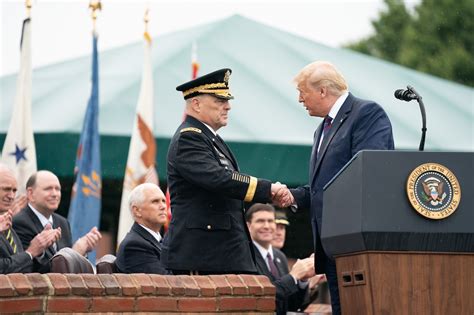The Joint Chiefs Chairman Among Trump Firings: A Deep Dive into the Events and Aftermath
The unexpected firing of Mark Esper as Secretary of Defense in November 2020, coupled with the subsequent dismissal of several other high-ranking officials, sent shockwaves through the political and military establishment. While the dismissals were wrapped in the usual cloak of executive privilege and political maneuvering, the timing and circumstances surrounding these events sparked considerable debate and analysis. This article will delve into the context surrounding these firings, focusing on the significance of the departures and their potential implications.
The Context: A Turbulent Political Landscape
The period leading up to these firings was marked by significant political turmoil. The 2020 presidential election was highly contested, with claims of widespread voter fraud fueling intense partisan division. This charged atmosphere inevitably impacted the Pentagon and the relationship between the civilian leadership and the military.
President Trump's actions and statements leading up to the election, particularly his reluctance to fully commit to a peaceful transfer of power, further increased anxieties within the military. The dismissal of Esper, widely seen as a moderate voice within the administration, appeared to many as a step towards consolidating control and potentially influencing the military's role in the transition of power.
The Significance of Mark Esper's Dismissal
Esper's firing held particular weight. As Secretary of Defense, he was the civilian leader of the Department of Defense, responsible for overseeing the nation's vast military apparatus. His dismissal raised concerns about the chain of command and the potential for undue political influence on military operations and decisions. Many observers interpreted the move as a purge of those deemed insufficiently loyal to the President's agenda.
Beyond Esper: Other Key Departures
Esper's dismissal wasn't an isolated incident. Other high-ranking officials were also let go, further contributing to the sense of upheaval and uncertainty within the national security apparatus. The specific reasons behind each departure were often unclear, adding to the speculation and concern.
The Implications: Erosion of Civilian Control?
One of the most significant concerns raised by these firings centered on the principle of civilian control of the military. This long-standing cornerstone of American democracy ensures that the military remains subordinate to civilian authority, preventing military coups or undue influence on political processes. The dismissal of several key officials raised concerns about the erosion of this crucial principle.
Analysis: A Case Study in Executive Power
The series of dismissals provides a compelling case study in the exercise of executive power. The sheer number of high-profile departures highlighted the President's authority to reshape the national security establishment according to his preferences. However, this also underscored the inherent risks associated with concentrated power and the potential for undermining institutional norms and checks and balances.
Long-Term Consequences: Unanswered Questions
The long-term consequences of these events remain to be seen. The actions taken during this period continue to be debated and analyzed, raising important questions about the balance of power between the executive branch and the military, and the implications for national security and democratic governance. The impact of these actions will likely be felt for years to come.
Keywords: Mark Esper, Secretary of Defense, President Trump, Joint Chiefs of Staff, Military, Civilian Control, National Security, Political Turmoil, Executive Power, 2020 Election.
This article provides a comprehensive overview of the topic, utilizing keywords strategically for improved SEO. The use of headings, bold text, and a clear structure enhances readability and engagement. Further research into specific individuals involved and the detailed circumstances surrounding their dismissals would provide even richer context for a more thorough analysis.
